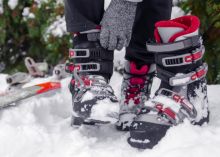
Quality of daily life is closely linked to the health of our feet. When faced with cold weather, many of us make footwear changes that reflect changing activities and comfort. Footwear is important for traction, warmth, preventing slips and falls, and support for daily activities, but footwear that is not properly fitted can cause discomfort and can result in painful conditions, such as the development of a bunion.
A bunion is a bump that forms on the joint of the big toe when bone or tissue moves out of place and extends beyond the normal anatomy of the toe. A bunion is not actually a growth or enlargement of the toe; rather, it is the result of the proximal foot bone (metatarsal) rotating out of place.
When you walk, the joint at the base of the big toe supports a lot of the body's weight. So, when a bunion forms at that joint and forces the big toe to curve toward the others, it can be quite painful. Left untreated, bunions can cause debilitating pain and may require surgery to correct.
Bunions can form for many reasons including anatomy, activity level and, commonly, footwear. Tight-fitting shoes, such as ski boots and high heels, may play a role in the development of a bunion. Worsening pain on the inside of the big toe while wearing certain shoes or boots can indicate a bunion deformity caused by footwear.
Not everyone with a bunion needs to see a doctor. Shoe modifications should be made at the onset of pain. To assess ill-fitting shoes, place a wet foot on a piece of paper and outline it with a marker. Compare that outline to your shoes and stop wearing any that are smaller than the outline of the foot.
When choosing new footwear, opt for wide or high toe boxes, which can be helpful in creating additional space and less friction. Often, a favorite pair of well-made shoes that are too tight can be taken to a cobbler or brace shop to stretch the shoe. Shoe inserts and orthotics specially fitted by a physical therapist or podiatrist are also effective at addressing pain caused by bunions.
If all shoes, regardless of modifications, cause pain in the area of a bunion, it is recommended to see a specialist so the cause can be addressed before it worsens. A specialist may begin with medical imaging of your foot and ankle to determine the cause of bunions, such as progressive flatfoot deformity, trauma or wear and tear resulting in arthritis.
Surgery may be recommended to correct the bunion and toe joint. The surgical procedure is personalized based on your individual anatomy and condition, and certain procedures can address other conditions like arthritis at the same time, making it a valuable treatment for long-term comfort.
If you are experiencing pain in your feet, take action. Don’t let the formation of a bunion keep you from the athletic activities you love.
To learn more about foot and ankle services, call (530) 543-5554 or visit BartonOrthopedicsAndWellness.com.
Visit BartonOrthopedicsAndWellness.com



 Dr. Paul Ryan is a board-certified orthopedic surgeon with Tahoe Orthopedics and Sports Medicine. He is a foot and ankle specialist treating patients in Carson City, Zephyr Cove and at the Barton Center for Orthopedics & Wellness in South Lake Tahoe, CA.
Dr. Paul Ryan is a board-certified orthopedic surgeon with Tahoe Orthopedics and Sports Medicine. He is a foot and ankle specialist treating patients in Carson City, Zephyr Cove and at the Barton Center for Orthopedics & Wellness in South Lake Tahoe, CA. 



